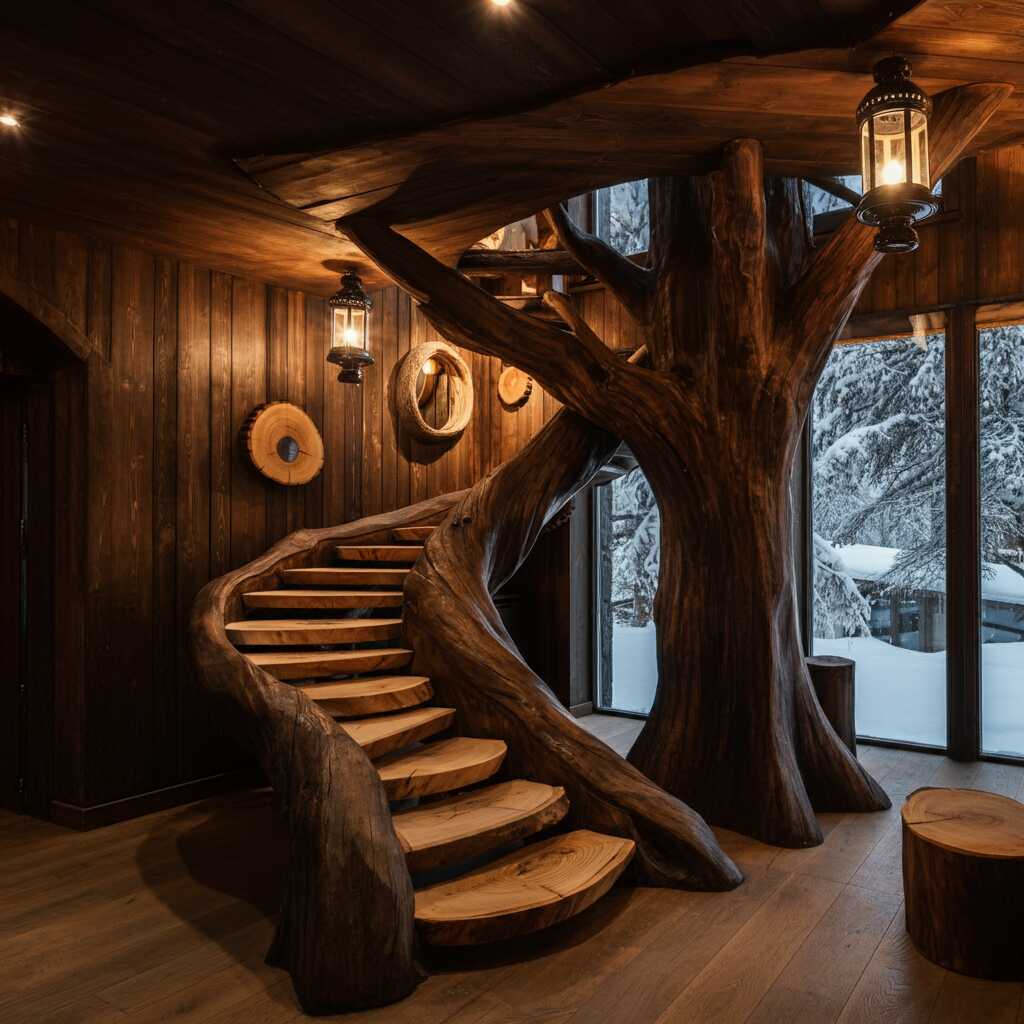In the world of interior design and artisanal furniture, few creations capture the imagination quite like a Live Edge Wood Epoxy River Table . This unique piece of functional art seamlessly blends the rugged beauty of natural wood with the sleek elegance of resin, resulting in a table that is as much a conversation starter as it is a centerpiece of any room. The allure of these tables lies not only in their visual appeal but also in the story they tell—a story of nature’s imperfections embraced, of time honored through preservation, and of craftsmanship elevated to an art form.
At its core, a Live Edge Wood Epoxy River Table is a stunning marriage between two contrasting materials: raw, unprocessed wood featuring its natural edge (the “live edge”), and epoxy resin that flows like a river through the gaps and voids in the wood. This combination results in a table that is both organic and modern, rustic yet refined. Each piece is inherently one-of-a-kind, bearing the distinct markings of the tree from which it was born—knots, cracks, bark remnants, and even insect trails—all preserved beneath a glossy, glass-like surface of cured epoxy.
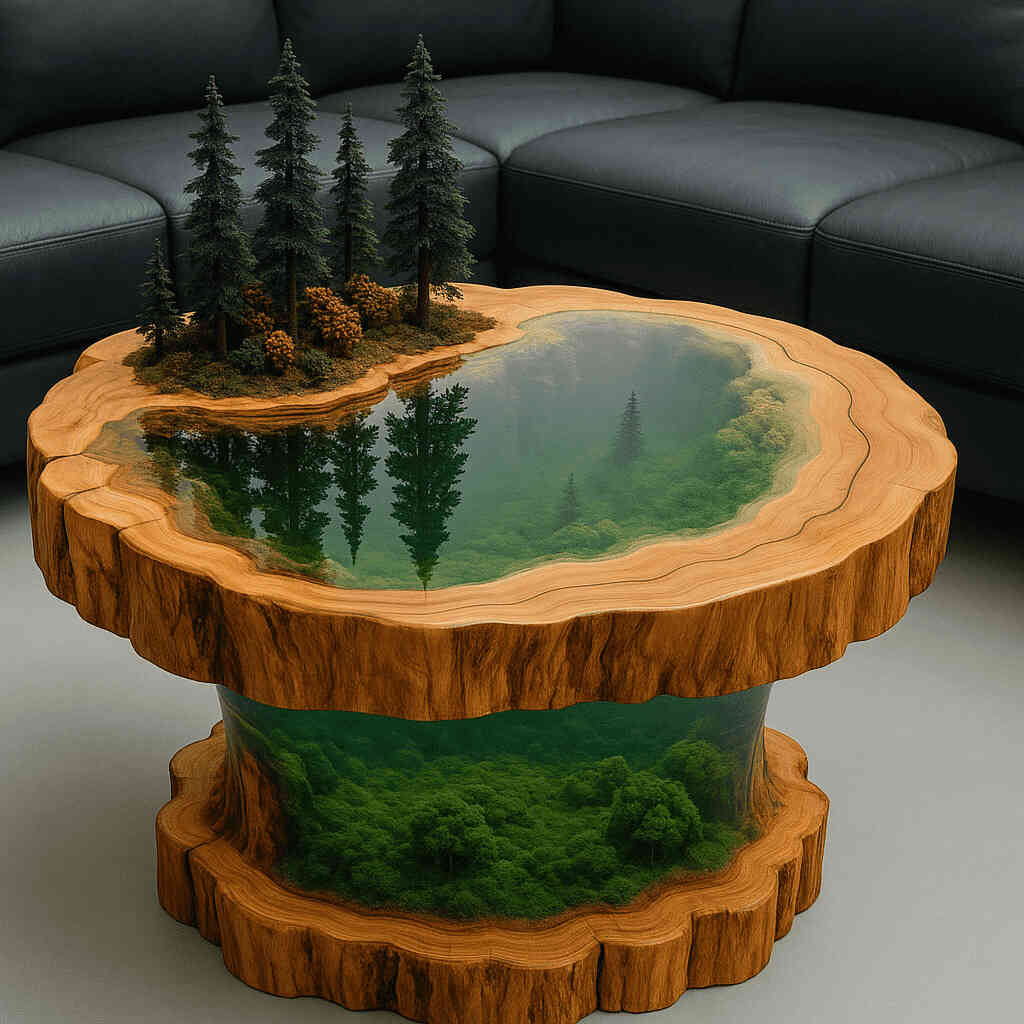
The rise in popularity of live edge furniture over the past decade has been driven by a growing appreciation for sustainable materials, natural aesthetics, and handcrafted uniqueness. In a world increasingly dominated by mass production and synthetic finishes, the Live Edge Wood Epoxy River Table stands out as a testament to individuality and environmental consciousness. It invites us to slow down, to notice the details, and to reconnect with the natural world in a deeply personal way.
This article will explore the intricate beauty of Live Edge Wood Epoxy River Tables by delving into three key areas: the origins and significance of live edge wood, the transformative role of epoxy resin in furniture design, and the artistic process behind crafting such a remarkable piece. Through this exploration, we aim to deepen our understanding of why these tables are more than just furniture—they are works of art that celebrate the harmony between nature and human creativity.
Part 1: The Essence of Live Edge Wood – Honoring Nature’s Imperfections
What Is Live Edge Wood?
To fully appreciate the beauty of a Live Edge Wood Epoxy River Table , we must first understand what sets live edge wood apart from other types of lumber. Unlike traditional milled wood that features straight, uniform edges, live edge wood retains the natural contours of the tree’s outer layer—the bark line and irregular shape where it once grew. This means each slab carries the unique fingerprint of the tree it came from, including curves, knots, and occasional imperfections like checks (cracks) or burls.
The term “live edge” refers to the untouched edge of the wood, often left in its original state after the tree is harvested. Rather than being cut away or smoothed out, this edge is preserved as a defining feature of the piece. The result is a material that speaks directly to the tree’s life history—its growth patterns, environmental conditions, and even injuries sustained during its lifetime.
Why Live Edge Wood Matters
Live edge wood represents a shift in how we perceive and use natural resources. Traditionally, woodworkers sought out flawless, clear pieces of lumber, discarding anything deemed imperfect. However, the resurgence of interest in natural materials has led to a reevaluation of what constitutes beauty in wood. Today, imperfections are not flaws to be hidden but rather characteristics to be celebrated. The presence of knots, grain variations, and natural edges adds depth and character, making each live edge table truly unique.
Moreover, using live edge wood aligns with sustainable practices. Often sourced from fallen or storm-damaged trees, or reclaimed from urban settings, this type of wood repurposes material that might otherwise go to waste. By choosing to work with live edge slabs, artisans honor the life of the tree while reducing the demand for newly harvested timber.
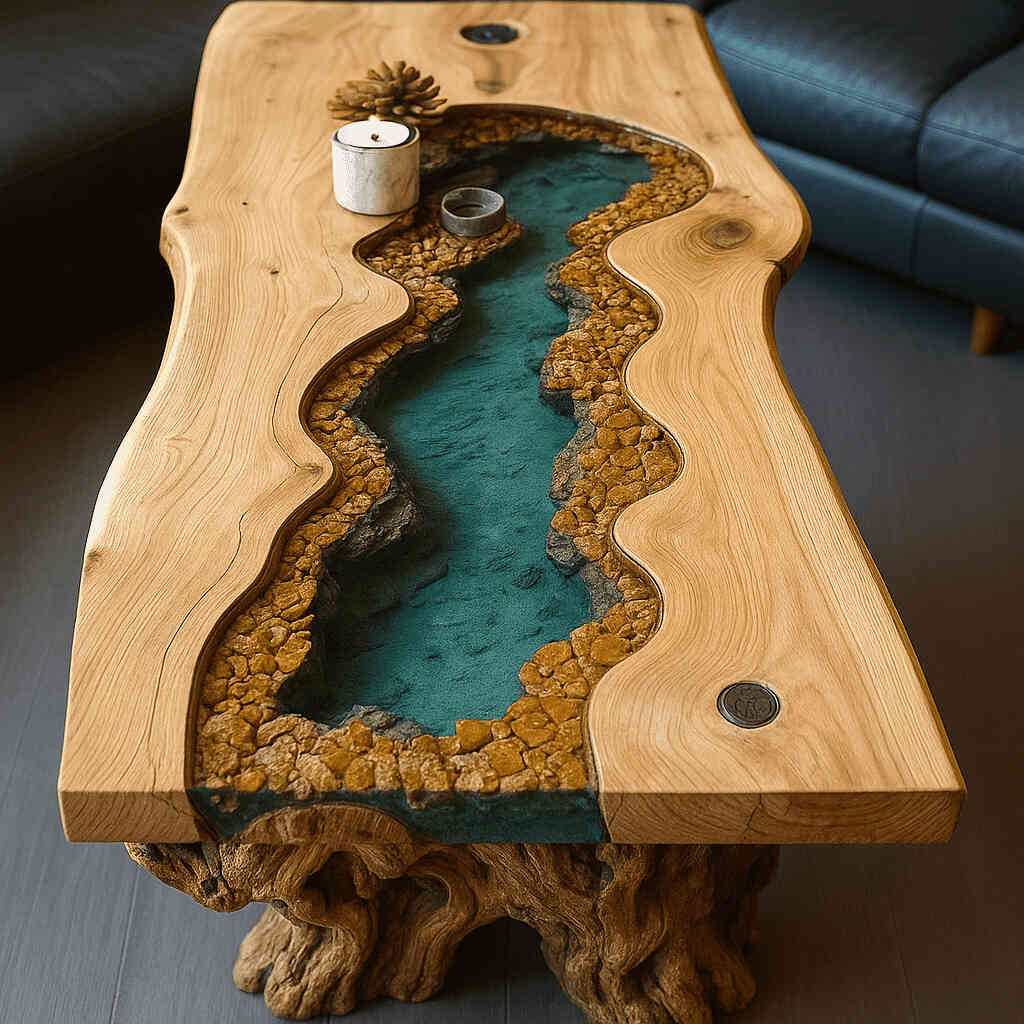
Emotional and Aesthetic Impact
There is something profoundly grounding about sitting at a table made from live edge wood. Its natural curves and textures evoke a sense of calm and connection to the earth. In interior spaces that may otherwise feel sterile or overly designed, a Live Edge Wood Epoxy River Table introduces warmth, authenticity, and a tactile quality that engages the senses.
The emotional resonance of live edge wood lies in its ability to tell a story. When you run your fingers along the undulating edge of a slab, you’re touching the memory of a living organism. You’re reminded that nothing in nature is perfectly symmetrical, and that beauty can emerge from asymmetry, decay, and transformation. This philosophy extends beyond furniture—it becomes a metaphor for embracing life’s imperfections and finding value in the unexpected.
In essence, live edge wood is not just a material; it is a celebration of nature’s resilience and diversity. It serves as the foundation upon which the rest of the Live Edge Wood Epoxy River Table is built, setting the stage for the next element of its creation: the flowing, luminous resin that gives the table its signature “river.”
Part 2: The Role of Epoxy Resin – Transforming Voids into Visual Poetry
Introducing Epoxy Resin in Furniture Design
Epoxy resin plays a pivotal role in the construction of a Live Edge Wood Epoxy River Table , transforming what might have been structural weaknesses or unusable gaps into striking visual elements. Resin is a thermosetting polymer known for its durability, clarity, and versatility. When mixed and poured correctly, it creates a smooth, glass-like surface that contrasts beautifully with the textured wood around it.
In the context of live edge furniture, epoxy resin is typically used to fill cracks, voids, and naturally occurring separations between wood slabs. These gaps are often stabilized with butterfly keys or wooden splines before being filled with colored or transparent resin. The result is a seamless integration of two very different materials—one ancient and organic, the other modern and synthetic—yet together forming a cohesive whole.
How Resin Enhances Natural Beauty
One of the most compelling aspects of using epoxy resin in live edge tables is its ability to highlight the inherent beauty of the wood. When applied carefully, resin acts as a lens, magnifying the grain patterns and color variations within the wood. It can be tinted with pigments or metallic powders to create a spectrum of effects—from deep blues and greens that mimic actual rivers, to translucent amber hues that echo the warmth of sunlight filtering through a forest canopy.
The reflective quality of cured resin adds another dimension to the table’s appearance. Depending on the lighting, the surface can appear almost liquid, giving the illusion of movement across the table’s surface. This dynamic interplay between light and material makes each Live Edge Wood Epoxy River Table a living piece of art, constantly changing with the environment.
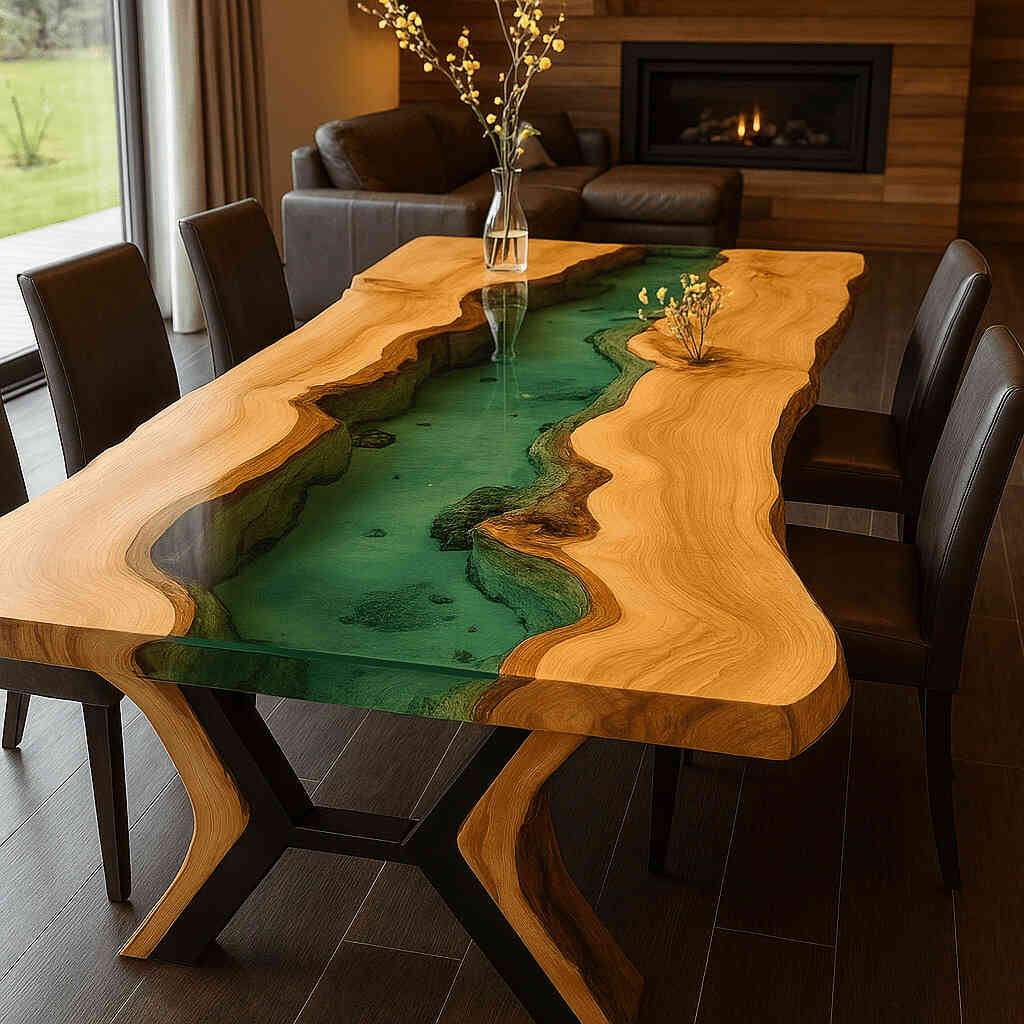
Technical Considerations in Resin Application
Creating a successful Live Edge Wood Epoxy River Table requires careful planning and execution. The process begins with selecting the right type of epoxy—typically a two-part system consisting of a resin and a hardener. The ratio of mixing, temperature, and humidity all play critical roles in ensuring proper curing and minimizing bubbles or imperfections.
Before pouring, the wood must be thoroughly dried to prevent moisture-related issues such as warping or resin separation. The surface is then sealed to prevent the epoxy from being absorbed unevenly. Once the resin is poured, it is often layered to achieve depth and avoid excessive heat buildup, which can cause cracking or cloudiness.
Artisans may incorporate additional elements into the resin, such as crushed stone, metal flakes, or even small botanical inclusions like flowers or leaves. These additions personalize the piece further, embedding meaning and symbolism into the design. Whether subtle or dramatic, these embellishments enhance the narrative of the table, turning it into a multidimensional artwork.
Sustainability and Longevity
While epoxy resin is a synthetic material, its application in live edge furniture contributes to sustainability in several ways. First, it allows for the preservation and stabilization of wood that might otherwise be discarded due to structural instability. Second, when properly maintained, a well-made Live Edge Wood Epoxy River Table can last for decades, resisting scratches, stains, and wear far better than untreated wood surfaces.
Furthermore, many modern resins are formulated with low volatile organic compounds (VOCs), making them safer for both the craftsman and the end user. Advances in eco-friendly resin technology continue to reduce the environmental footprint of this technique, allowing for a balance between aesthetic innovation and ecological responsibility.
Through the strategic use of epoxy resin, craftsmen elevate live edge wood from a raw material into a canvas for expression. The resin does not merely fill space—it tells a story, enhances texture, and transforms the table into a visual experience that invites contemplation and admiration.
Part 3: The Artistry Behind Crafting a Live Edge Wood Epoxy River Table
From Concept to Creation: The Design Process
Crafting a Live Edge Wood Epoxy River Table is a meticulous and thoughtful process that begins long before the first slab is cut or the first drop of resin is poured. The journey starts with the selection of the wood itself. Artisans often search for slabs that exhibit strong character—unique grain patterns, interesting knots, or dramatic curvature. The goal is not to find perfection, but rather to identify wood that tells a compelling story and offers opportunities for creative enhancement.
Once the slabs are chosen, the designer considers how to best integrate the resin elements. This involves sketching out potential layouts, determining where the “river” will flow, and deciding whether to incorporate multiple slabs or a single wide piece. The placement of the resin channels is crucial, as it influences the overall balance and visual flow of the table. Too much resin can overwhelm the wood, while too little may fail to create the desired effect.
Structural integrity is another important consideration. Since live edge slabs can be heavy and prone to movement due to changes in humidity, supports must be carefully engineered. Steel legs, trestles, or custom bases are often used to ensure stability without detracting from the natural aesthetic. The base should complement the table’s design, enhancing rather than competing with the main piece.
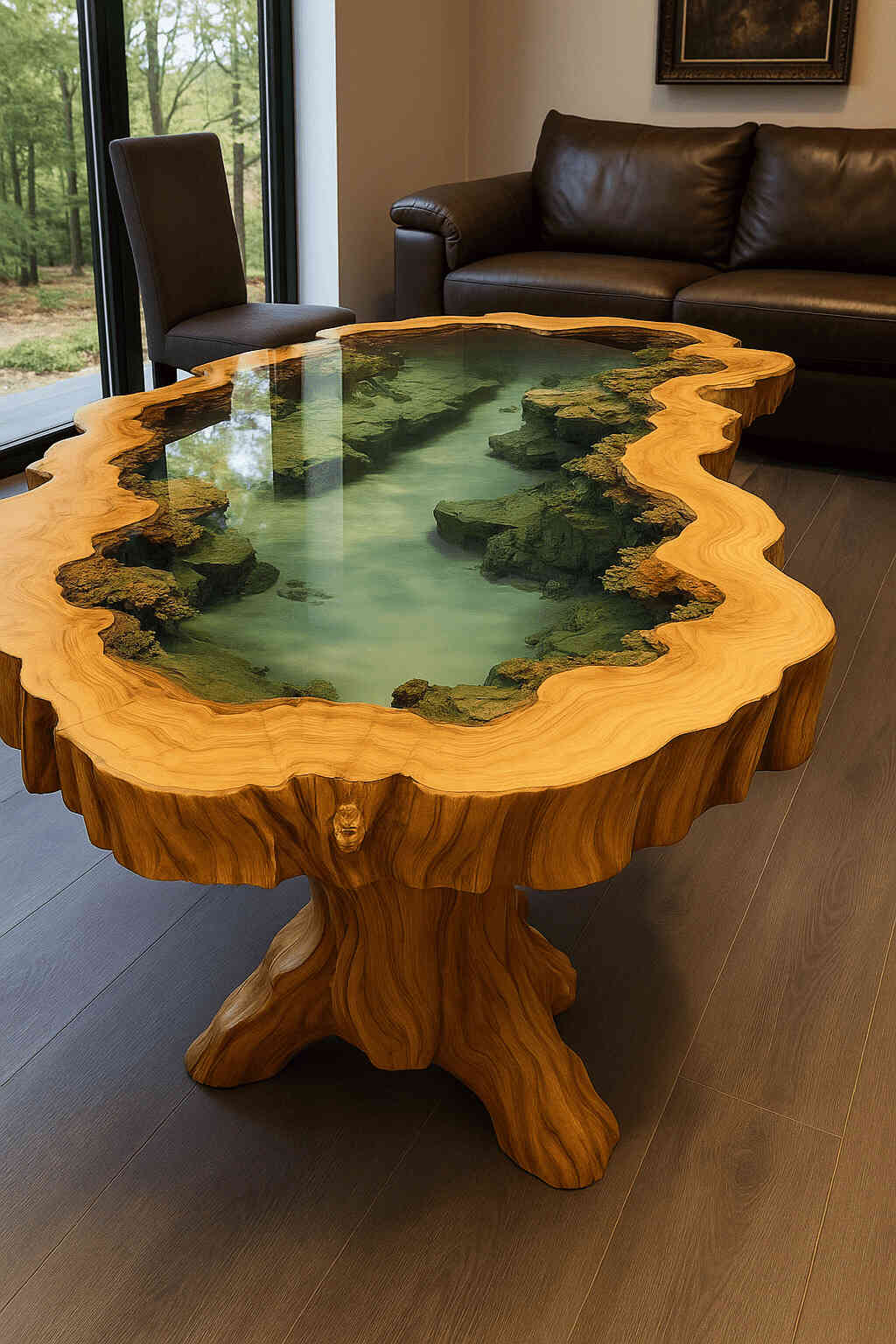
The Craftsmanship Involved
Every step in the creation of a Live Edge Wood Epoxy River Table demands precision, patience, and respect for the materials. After the slabs are selected and acclimated, they undergo a thorough preparation phase. This includes planing, sanding, and sealing the wood to prepare it for the resin. Any cracks or voids are reinforced to prevent further splitting during the drying and finishing stages.
The resin application itself is a delicate operation. Multiple layers may be required to achieve the desired depth and clarity. Between each pour, the resin must cure fully, often taking several days depending on the formula and environmental conditions. During this time, artisans monitor the progress closely, removing air bubbles with heat guns or torches and adjusting the placement of decorative inclusions as needed.
After the final coat has cured, the entire surface is sanded and polished to a mirror-like finish. This process can take many hours, as achieving a flawless surface requires attention to detail and repeated passes with progressively finer grits of sandpaper. The end result is a table that feels as smooth as glass but retains the warmth and texture of the underlying wood.
Personalization and Meaning
One of the most profound aspects of creating a Live Edge Wood Epoxy River Table is the opportunity for personalization. Many artisans collaborate with clients to incorporate meaningful elements into the design—such as family heirlooms embedded in the resin, symbolic colors representing significant life events, or even local materials like stones or shells collected from a memorable location.
These personalized touches transform the table from a beautiful object into a deeply personal artifact. It becomes a vessel for memories, emotions, and connections. For some, the table commemorates a milestone; for others, it serves as a reminder of nature’s enduring presence in daily life.
Even in cases where no specific narrative is intended, the act of preserving a tree’s legacy in this way imbues the table with a quiet dignity. It acknowledges the passage of time, the cycle of growth and decay, and the enduring beauty that can emerge from both.
The Final Reveal
When the table is complete, the moment of unveiling is often met with awe. The contrast between the rough-hewn wood and the gleaming resin creates a visual rhythm that draws the eye across its surface. Light dances differently on each section, revealing hidden details and textures that were not immediately apparent. The viewer is invited to trace the path of the “river,” to observe the interplay between solid and fluid, natural and man-made.
More than just a piece of furniture, the Live Edge Wood Epoxy River Table becomes a focal point in the space it inhabits. It sparks conversations, inspires curiosity, and evokes a sense of reverence for the natural world. It reminds us that beauty exists not only in symmetry and polish but also in the irregularities and unpredictability of life itself.
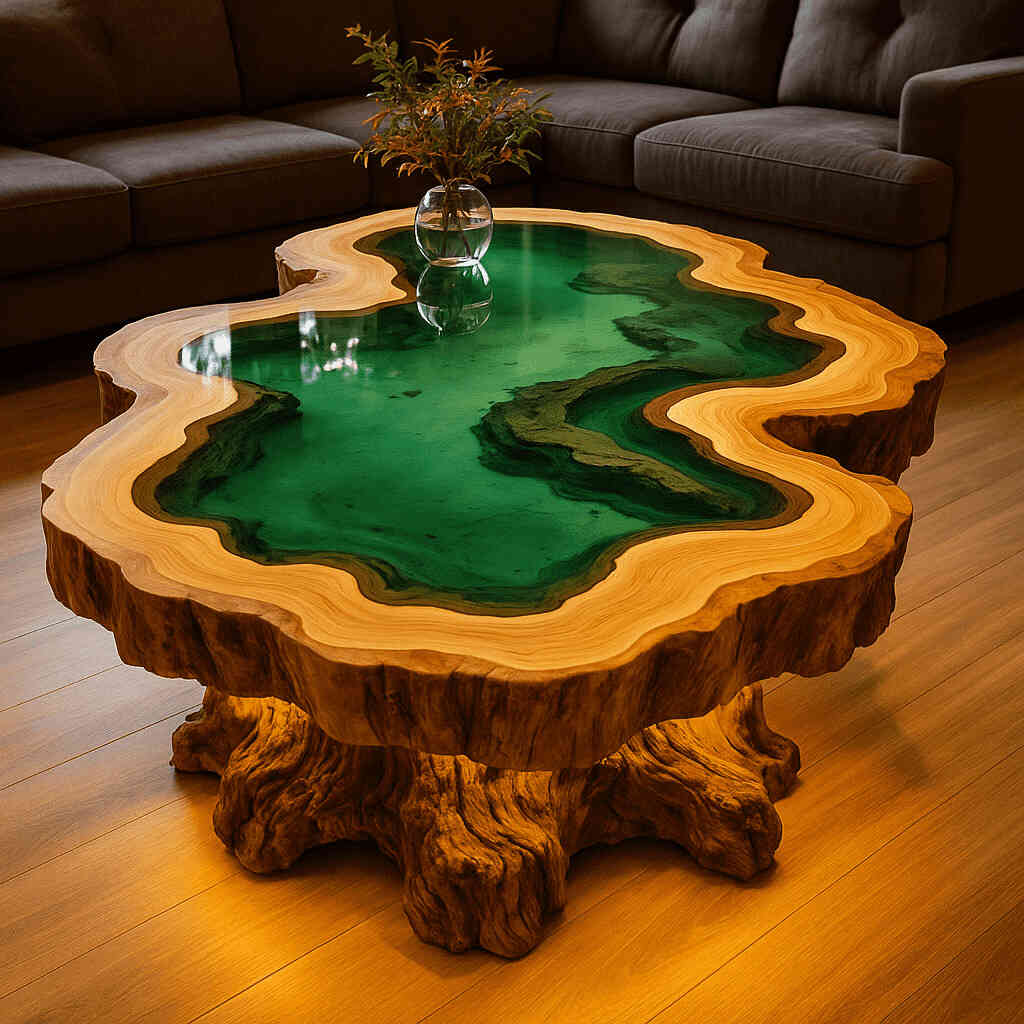
Conclusion: Embracing the Harmony of Nature and Human Creativity
A Live Edge Wood Epoxy River Table is more than a statement piece of furniture—it is a bridge between the wildness of nature and the refinement of human artistry. It invites us to see beauty in imperfection, to cherish the marks left by time and weather, and to recognize the potential for transformation in every broken line and empty space.
Through the careful selection of live edge wood, the innovative use of epoxy resin, and the meticulous craftsmanship involved in its creation, each table becomes a unique expression of both the tree it came from and the hands that shaped it. It is a testament to sustainability, creativity, and the enduring relationship between humanity and the natural world.
As we move forward in a rapidly evolving world, the Live Edge Wood Epoxy River Table serves as a gentle reminder to slow down, to look closely, and to find wonder in the everyday. It challenges us to rethink our relationship with materials, to appreciate the stories embedded in the objects we surround ourselves with, and to embrace the beauty of things that are not perfect—but deeply real.
In every curve, every ripple of resin, and every knot preserved in time, the Live Edge Wood Epoxy River Table whispers a quiet truth: that the most meaningful designs are those that honor both origin and evolution, that celebrate the past while shaping the future.

